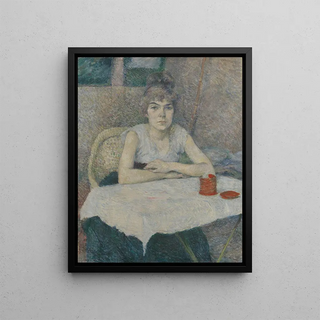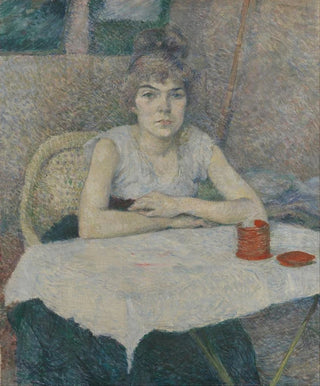Art print | Young woman at a table Poudre de riz - Henri de Toulouse-Lautrec


View from behind

Frame (optional)
In the fascinating world of art, some works manage to capture the essence of an era while transcending the limits of time. "Young woman at a table Poudre de riz - Henri de Toulouse-Lautrec" is one of those iconic creations that evoke the beauty and melancholy of Parisian life at the end of the 19th century. This piece, imbued with delicacy and subtlety, immerses us in an intimate moment where the young woman, absorbed in her thoughts, seems both present and distant. The soft light caressing her face and the delicate texture of her clothing invite us to explore not only her inner world but also the vibrant atmosphere of a Paris brimming with artistic energy.
Style and uniqueness of the work
Toulouse-Lautrec's style is distinguished by its bold and innovative approach. In "Young woman at a table Poudre de riz," the artist uses pastel colors and flowing lines to create a delicate and dreamy atmosphere. The shades of pink and blue blend harmoniously, emphasizing the fragility of the female figure. This painting perfectly illustrates how Toulouse-Lautrec manages to capture fleeting moments with such intensity. The composition, focused on the young woman, evokes a striking intimacy, while the blurred background suggests a lively Parisian environment. This work also reveals the artist's interest in the world of cabarets and salons, where beauty and decadence coexist, offering a fascinating contrast that captures the eye and the imagination.
The artist and his influence
Henri de Toulouse-Lautrec, an emblematic figure of post-impressionist art, established himself through his unique style and his ability to capture the essence of Parisian nightlife. Born into an aristocratic family, he was quickly drawn to popular culture and scenes of everyday life. His work is not limited to simple representation but explores the emotions and hidden stories behind each character. Toulouse-Lautrec influenced many artists and movements, notably Fauvism and Expressionism, thanks to his use

Matte finish

View from behind

Frame (optional)
In the fascinating world of art, some works manage to capture the essence of an era while transcending the limits of time. "Young woman at a table Poudre de riz - Henri de Toulouse-Lautrec" is one of those iconic creations that evoke the beauty and melancholy of Parisian life at the end of the 19th century. This piece, imbued with delicacy and subtlety, immerses us in an intimate moment where the young woman, absorbed in her thoughts, seems both present and distant. The soft light caressing her face and the delicate texture of her clothing invite us to explore not only her inner world but also the vibrant atmosphere of a Paris brimming with artistic energy.
Style and uniqueness of the work
Toulouse-Lautrec's style is distinguished by its bold and innovative approach. In "Young woman at a table Poudre de riz," the artist uses pastel colors and flowing lines to create a delicate and dreamy atmosphere. The shades of pink and blue blend harmoniously, emphasizing the fragility of the female figure. This painting perfectly illustrates how Toulouse-Lautrec manages to capture fleeting moments with such intensity. The composition, focused on the young woman, evokes a striking intimacy, while the blurred background suggests a lively Parisian environment. This work also reveals the artist's interest in the world of cabarets and salons, where beauty and decadence coexist, offering a fascinating contrast that captures the eye and the imagination.
The artist and his influence
Henri de Toulouse-Lautrec, an emblematic figure of post-impressionist art, established himself through his unique style and his ability to capture the essence of Parisian nightlife. Born into an aristocratic family, he was quickly drawn to popular culture and scenes of everyday life. His work is not limited to simple representation but explores the emotions and hidden stories behind each character. Toulouse-Lautrec influenced many artists and movements, notably Fauvism and Expressionism, thanks to his use






